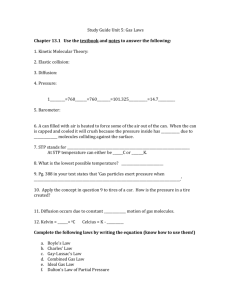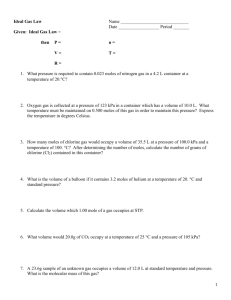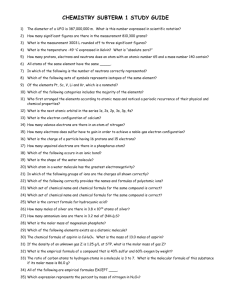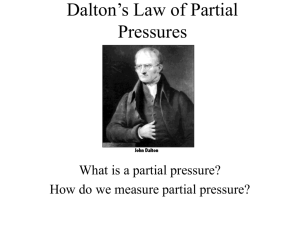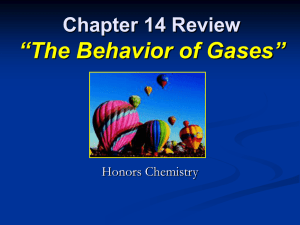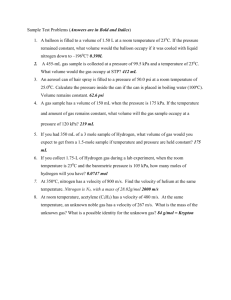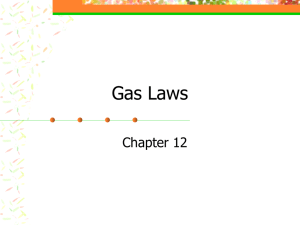Chapter 14 Review *The Behavior of Gases*
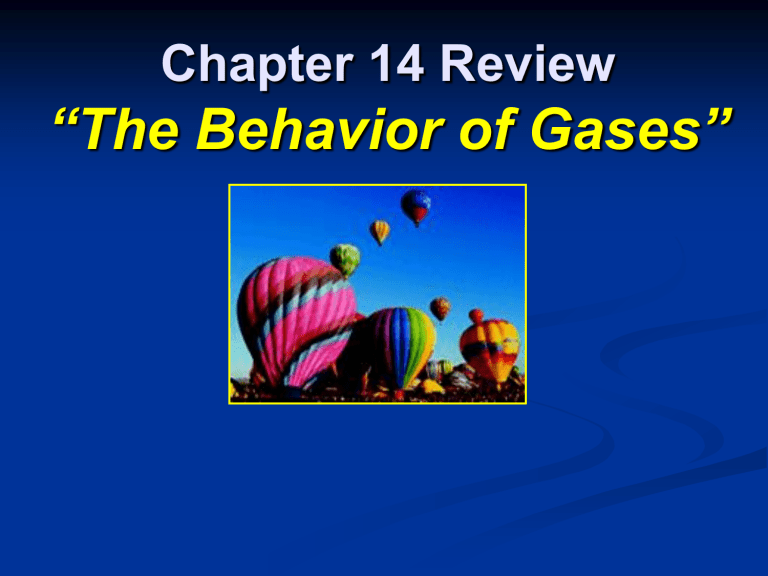
Chapter 14 Review
“The Behavior of Gases”
Chapter 14 Review
Charles’s law states that ____.
As the temperature of a fixed volume of a gas increases, the pressure will ____.
Which gas law can be used to calculate the number of moles of a contained gas?
Chapter 14 Review
Boyle’s law states that ____.
Which of the following atoms would have the greatest velocity if each atom had the same kinetic energy? a) ammonia, or b) hydrogen
Chapter 14 Review
Why does air escape from a tire when the tire valve is opened?
The tendency of molecules to move from high concentration toward areas of lower concentration is called ____.
What happens to the pressure of a gas inside a container if the temperature of the gas decreases?
Chapter 14 Review
Which of the following gases will effuse the most rapidly ? a) chlorine, or b) hydrogen
How does the gas propellant move when an aerosol can is used?
Under what conditions of temperature and pressure is the behavior of a real gas most like that of an ideal gas?
Chapter 14 Review
The volume of a gas is doubled while the temperature is held constant. So, how does the gas pressure change ?
What does the ideal gas law allow a scientist to calculate that the other gas laws do not?
Chapter 14 Review
How is the ideal gas law usually written?
The combined gas law relates which items together?
If a balloon is squeezed, what happens to the pressure of the gas inside the balloon?
Which of the following gases is the best choice for inflating a balloon that must remain inflated for a long period of time: a) argon, or b) hydrogen?
Chapter 14 Review
At low temperatures and pressures, how does the volume of a real gas compare with the volume of an ideal gas under the same conditions?
If the volume of a container of gas is reduced, what will happen to the pressure inside the container?
In general, for a gas at a constant volume, the pressure of the gas is ____ proportional to its Kelvin temperature.
Chapter 14 Review
Why does the pressure inside a container of gas increase if more gas is added to the container?
Why is a gas easier to compress than a liquid or a solid?
Chapter 14 Review
The gaseous product of a reaction is collected in a 25.0 L container at
27 o C. The pressure in the container is 300.0 kPa .
How many moles of the gas are in the container? (3 mol)
Chapter 14 Review
A balloon filled with helium has a volume of 30.0 L at a pressure of 100 kPa and a temperature of 15.0 o C.
What will the volume of the balloon be if the temperature is increased to
80.0 o C and the pressure remains constant? (36.8 L)
Chapter 14 Review
The volume of a gas is 250 mL at
340.0 kPa pressure. What will the volume be when the pressure is reduced to 50.0 kPa, assuming the temperature remains constant?
(1700mL)
A gas occupies a volume of 140 mL at 35.0 o C and 97 kPa. What is the volume of the gas at STP? (119 mL)
Chapter 14 Review
A gas has a volume of 590 mL at a temperature of -55.0 o C.
What volume will the gas occupy if the temperature changes to 30.0 o C?
(820 mL)
What is the pressure exerted by
32 g of O
2 in a 22.0 L container at
30.0 o C? (1.13 atm)
Chapter 14 Review
A rigid container of O
2 has a pressure of 340 kPa at a temperature of 713 K. What is the pressure at 273 K? (130 kPa)
A gas has a pressure of 710 kPa at
227 o C.
What will its pressure be at
27 o C, if the volume does not change? (440 kPa)
Chapter 14 Review
Use Graham’s law to calculate how much faster fluorine gas (F
2 effuse than chlorine gas (Cl molar mass of F
2 mass of Cl
2
= 70.9. 1.37X
) will
2
). Use the
= 38.0; the molar
Chapter 14 Review
How many moles of N
2 are in a flask with a volume of 250 mL at a pressure of 3 atm and a temperature of 300.0 K? (0.03 mol)
